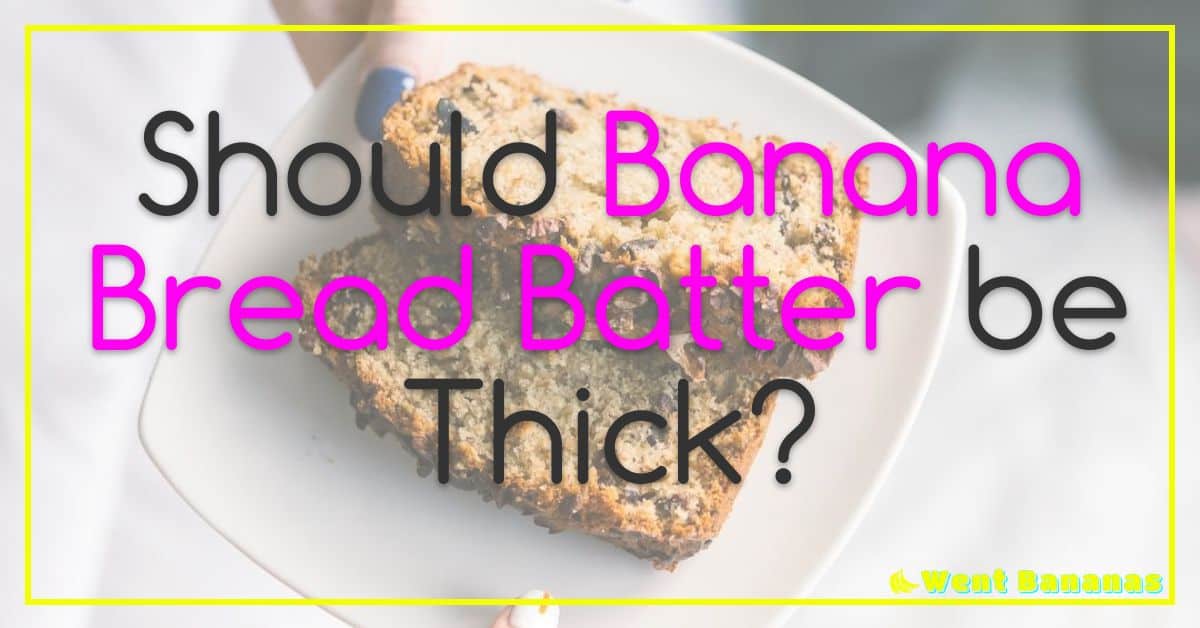Do you enjoy the tantalizing waft of banana bread baking in the oven? Its hearty aroma is a delight for your senses, but the key to a successful and scrumptious loaf is in the batter. Should it be thick or thin?

Explore the nuances of this popular treat and decide for yourself. Read on to discover more!
The history and origin of Banana Bread
Banana bread is one of the oldest recipes, originating as a way to make use of overripe bananas. The original recipe for banana bread dates back to the early 20th century and was first published in 1933 in Pillsbury’s Balanced Recipes cookbook.

The recipe was simple yet effective, allowing people to turn browning bananas into something delicious. Over time, modifications have been made to the original recipe resulting in a wide range of variations and flavors. One major debate when it comes to banana bread is should the batter be thick or thin.
The answer largely depends on preference as there are benefits to both options. For those who prefer a denser texture, a thin batter will allow it to hold together better while baking and result in a more robust flavor and an even distribution of ingredients throughout the dessert.
On the other hand, baking with thick batter results in a slightly more cake-like texture that remains moist even after cooling down completely. Ultimately, whichever type you choose will depend on individual taste preferences and how you want your banana bread to turn out!
Benefits of a thicker batter for banana bread
When it comes to baking banana bread, many people are curious if having thicker batter results in better-tasting bread. The answer is yes! A thicker batter can result in a moister, more flavorful banana bread.
This is because the thicker batter will help prevent the loaf from becoming dry during baking. Additionally, it gives the loaf more structure and shape so that it can stand up to slicing and serving.
Moreover, when batters are too thin they may not bake evenly, resulting in an inconsistent texture throughout the loaf.
Having a thick batter ensures consistent results every time you bake your banana bread. Lastly, a thick batter also helps trap steam during baking which helps create an airier texture for each slice of bread you enjoy!
A Step-by-Step Guide to Making the Perfect Thick Batter for Banana Bread
Banana bread is a beloved treat that has been enjoyed for generations. The key to making the perfect loaf lies in getting the batter just right – thick but not too thick. To ensure your banana bread comes out perfectly every time, here is a step-by-step guide to making the ideal batter.
First, gather all of your ingredients and measure them according to the recipe instructions. Then, mash the bananas together until they are smooth with no lumps remaining. If you need extra moisture for your batter, add a tablespoon or two of milk or yogurt to create a creamy texture.
Next, combine all of your wet ingredients together in one bowl and mix thoroughly until there are no clumps left.

In another bowl, sift together all of the dry ingredients such as flour and baking soda before slowly adding them to the wet mixture and stirring until everything is combined evenly without lumps or clumps forming throughout.
Once you have your final mixture ready, it should be thick enough that it holds its shape when spooned onto a plate — not runny like pancake batter — but still soft enough that it can easily be scooped up with a spatula or spoon without leaving any sticky residue behind on cookware surfaces like cookie dough would do so readily!
Lastly, top off your banana bread mixture with some walnuts or other nuts if desired before baking at 350 degrees Fahrenheit (175°C) for 35-40 minutes depending on the pan size used – enjoy!
Four common mistakes to avoid when making a thick batter for banana bread
When making a thick batter for banana bread, it is important to avoid some common mistakes. To achieve the desired result of a moist and fluffy loaf, here are four tips to keep in mind:
1. Don’t over-mix the batter. Over-mixing can cause the gluten in the flour to become too elastic and create a tough texture in the finished product. Stir just until all ingredients are combined for best results.
2. Use room temperature ingredients if possible. Cold butter or eggs can cause lumps in the batter that will be difficult to mix out without overworking it, so it’s best to use ingredients at room temperature whenever possible.

« Can You Eat Bananas with Braces?
Why Do Banana Leaves Turn Yellow? »
3. Don’t add extra liquid unless necessary; too much liquid can make your banana bread dense and gummy rather than light and fluffy as desired! If additional moisture is needed, add small amounts of milk or juice until desired consistency is reached — but no more than 1/4 cup total!
4 Finally, don’t worry about making your banana bread batter perfectly smooth – small lumps will dissolve as it bakes! Just be sure not to over mix or you may end up with an undesirably tough loaf of bread when all is said and done!
Nutritional information about thick banana bread batter
When it comes to baking banana bread, one of the most important factors is knowing how thick the batter should be. Thick batters can give the finished product a denser texture, while thinner batters will result in a lighter loaf.
Fortunately, there are several nutritional benefits associated with thicker banana bread batters that make them an ideal choice for those looking to get more out of their baked goods.
A thicker batter made with ripe bananas can provide more fiber and potassium than a thinner batter. This helps boost digestion and aids in maintaining healthy blood pressure levels. Additionally, thicker batters also contain more natural sugars from the fruits which helps create a rich flavor as well as added sweetness to the finished loaf.
Finally, thicker banana breads have been observed to retain moisture better than thinner ones due to their dense structure and higher fat content from nuts or other ingredients like coconut oil that may be included in the recipe.
This makes them perfect for longer storage periods and can prevent them from becoming dry or stale too quickly when served fresh out of the oven or after cooling down for later consumption.













